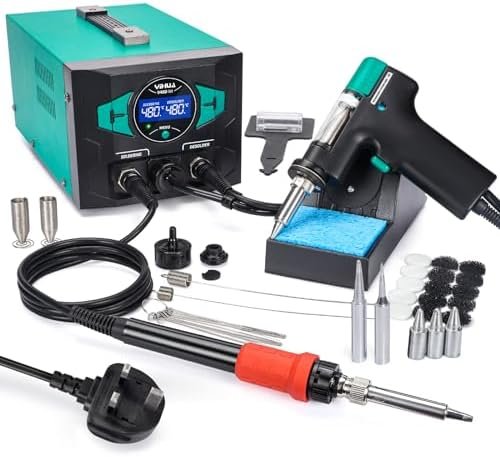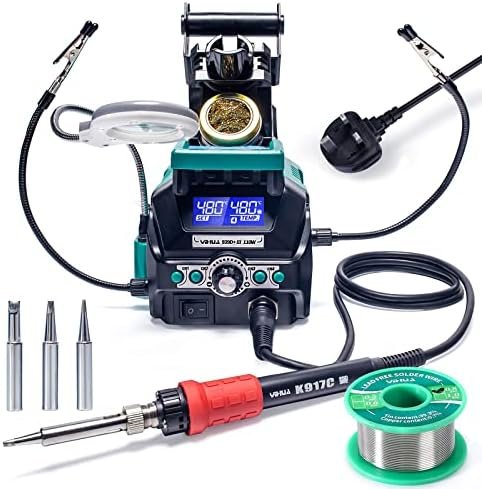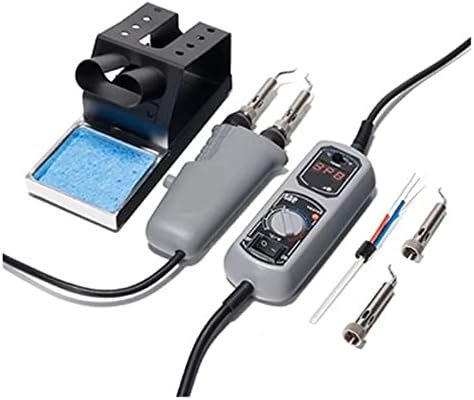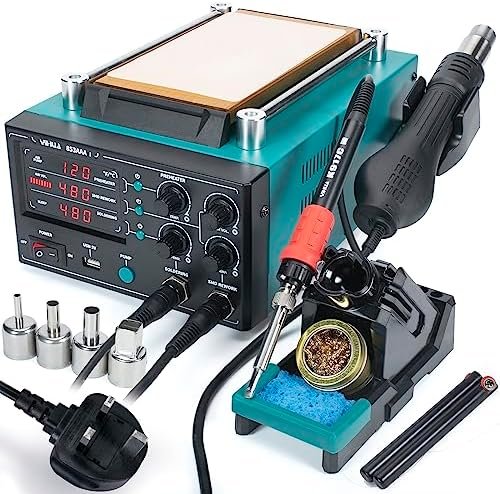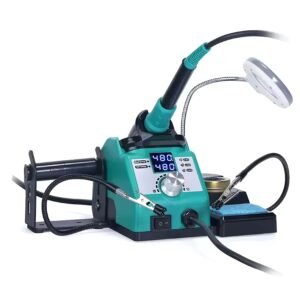Soldering exposes you to high heat and hazardous fumes, making safety gear essential. This guide covers the crucial protective equipment you need to work confidently while minimizing risks, ensuring long-term safety and success in your projects.
Soldering can be risky without the right protection from heat and fumes. Discover the essential safety gear you need to work confidently and safeguard your health long-term.
High temperatures and toxic fumes are part of soldering, but the right safety gear can minimize the risks. Learn how each item of protective equipment plays a crucial role in keeping you safe.
Protecting yourself during soldering goes beyond immediate accidents—it’s about long-term safety. Explore the key safety gear that lets you work securely while enhancing your productivity.
Importance of Wearing Safety Gear
One big concern is breathing in solder fumes. These fumes contain chemicals that can harm your lungs over time, especially if you work without good ventilation or a mask. They can lead to breathing issues or even more serious health problems.
Another risk is burns. Soldering irons get very hot and can easily burn your skin.
For example, not wearing eye protection can lead to eye injuries from sparks or solder splashes. Each of these situations shows why it’s so important to wear the right safety gear.
By consistently using safety gear like eye protection, and a mask, can significantly lower these risks and ensure they stay safe and healthy.
Types of Essential Safety Gear
Here are three crucial types of safety gear that every soldering workstation should have:
Safety Goggles
Protect your eyes from sparks and solder splashes. These small but potentially dangerous occurrences can happen unexpectedly during soldering tasks, posing a significant risk to your vision. Safety goggles are designed with impact-resistant lenses and wrap-around frames to provide complete coverage and protection against flying debris and chemical splashes.
Soldering Fume Extractors
They play a vital role in maintaining good air quality in your workspace. They effectively remove harmful fumes and airborne particles that are generated during soldering. These fumes contain chemicals and metals such as lead and flux vapors, which, if inhaled over time, can lead to respiratory issues and other health problems. Soldering fume extractors work by drawing in contaminated air through a filter system that captures and traps harmful particles before releasing clean air back into the environment.
Necessary Materials For Soldering
To successfully and safely solder, several key materials are essential. Solder, an alloy typically composed of tin and lead, is melted to create strong electrical connections between components. Flux is used to clean and prepare metal surfaces before soldering, facilitating better solder flow and reducing oxidation. Tip tinner is crucial for maintaining soldering iron tips, ensuring efficient heat transfer during soldering tasks.
When working with these materials, it’s important to observe proper handling and safety precautions. Firstly, ensure you work in a well-ventilated area to minimize exposure to solder fumes, which can be harmful when inhaled over time. If ventilation is inadequate, consider using a fume extractor to remove airborne contaminants effectively.
Eye protection is essential; wearing safety goggles protects against potential splashes or accidental contact with hot solder or flux. Proper storage of solder and flux in tightly sealed containers helps prevent contamination and maintains their effectiveness over time.
Soldering Flux
Flux is crucial in soldering for clean, reliable electrical connections. It cleans metal surfaces by removing oxides and contaminants that hinder solder bonding, ensuring smooth, uniform adhesion for strong electrical bonds. Additionally, flux helps solder spread evenly, improving conductivity and joint reliability without gaps or cold spots.
To use flux safely:
- Work in a well-ventilated area to avoid inhaling fumes. Use a fume extractor if ventilation is poor.
- Wear safety goggles or a face shield to protect against splashes.
- Avoid prolonged skin contact; wash affected areas promptly with soap and water.
- Store flux in its original container in a cool, dry place away from heat and sunlight to maintain effectiveness and prevent contamination.
Solder Wire
Solder wire comes in different types, each with specific safety considerations. Here’s what you need to know:
Lead vs. Lead-Free Solder
Lead solder is traditionally used for its ease of use and low melting point, lead solder contains lead, which is hazardous if ingested or inhaled over time. Proper handling and disposal are crucial to prevent exposure.
Lead-Free Solder is made from alternative metals like tin, silver, or copper, lead-free solder is safer environmentally and health-wise. It requires higher melting temperatures but avoids the risks associated with lead.
Check Our Store for Soldering Irons
Safety When Handling Lead Solder
When working with lead solder, follow these safety precautions:
- Work in a well-ventilated area or use a fume extractor to avoid inhaling lead fumes.
- Wash hands thoroughly after handling lead solder to prevent ingestion through accidental contact with mouth or food.
- Store lead solder securely in its original packaging to prevent spills and keep it away from children and pets.
- Dispose of lead solder waste properly according to local regulations to prevent environmental contamination.
Safe Soldering Techniques
Soldering is a skill that requires precision and care, not just for the success of your projects but also to ensure your personal safety. Let’s explore some essential techniques to handle a soldering iron safely and methods to prevent burns.
How to Hold a Soldering Iron Safely
Holding a soldering iron correctly is key to both effective soldering and safety. It’s best to grip the soldering iron like a pencil, near the base of its handle, which provides maximum control over the tool. This position keeps your fingers away from the hot tip, reducing the risk of accidental burns. Also, ensure your grip is relaxed but firm to maintain precision in your soldering without causing hand fatigue. This grip not only enhances safety but also improves the accuracy of your work.
Preventing Soldering Burns
Burns are a common hazard in soldering, but you can minimize this risk with the right precautions:
Always place the soldering iron on a heat-resistant mat or a proper stand when it’s not in use. This prevents the hot tip from coming into contact with flammable materials or your skin.
Keep your soldering area free of unnecessary clutter and ensure all flammable materials are well away from the heat source. A tidy workspace not only prevents accidents but also makes it easier to focus on the task at hand.
Work in a well-ventilated area to disperse heat and smoke from the soldering process. This not only helps prevent inhalation of toxic fumes but also keeps the area cool, reducing the likelihood of heat-related accidents.
Check our Store For Soldering Stations
Proper Ventilation for Soldering
Proper ventilation is crucial in soldering to ensure a safe and healthy working environment. Fume extractors are designed to suck away harmful fumes right at their source, preventing them from spreading into the room and being inhaled. These devices are particularly valuable when working in enclosed spaces where natural airflow is limited.
They help maintain clean air, reducing the risk of respiratory problems and other health issues associated with inhaling solder fumes. Fume extractors also capture fine particulate matter from the solder, further enhancing air quality and safety.
Alternatives to Fume Extractors
If a fume extractor is not available, there are other effective ways to ensure adequate ventilation:
Work in Well-Ventilated Areas
Whenever possible, choose to solder in well-ventilated areas such as near open windows or in spaces with good airflow. This helps disperse fumes naturally, reducing their concentration and potential health impacts.
Use of Exhaust Fans
Installing an exhaust fan near your soldering station can help pull the fumes away from your breathing zone and expel them outdoors. This is a practical solution for improving air movement and reducing the build-up of hazardous fumes.
How to Maintain Safety Gear
Proper maintenance and storage of safety gear are crucial for ensuring its longevity and effectiveness. Regularly check your safety gear for any signs of wear, such as cracks or tears. It’s important to keep all gear clean, using mild soap and water for most items to remove dust, grime, and chemical residues that could compromise their protective qualities.
For maintaining electronic equipment like fume extractors, adhere to the manufacturer’s guidelines, which often involve routine cleaning of filters and surfaces. Proper storage is also key; keep all safety gear in a cool, dry place away from direct sunlight and extreme temperatures. This helps prevent materials from degrading and ensures that the gear remains in good working condition.
Additionally, be proactive about replacing any item of safety gear that shows signs of deterioration or no longer functions as intended. Regular updates of components like filters in fume extractors are essential, as worn-out filters can significantly reduce effectiveness
Risks of Not Using Proper Safety Gear
Not using proper safety gear while soldering can lead to a variety of risks and hazards, impacting both immediate and long-term health and safety. Here are some of the potential consequences:
Exposure to Toxic Fumes
Soldering can release harmful fumes, such as those from flux, which can contain chemicals like rosin or lead. Inhaling these fumes over time can lead to respiratory problems, including asthma and other serious lung conditions.
Eye Injuries
Without protective goggles, there is a high risk of eye injuries from splashes of molten solder or sparks. These injuries can range from minor irritations to severe damage, potentially leading to permanent vision impairment.
Skin Burns
Soldering irons and molten solder operate at high temperatures, posing a significant risk of burns. Direct contact with these hot materials can cause immediate pain and severe burns, requiring medical treatment and possibly leading to scarring.
Long-term Health Issues
Prolonged exposure to solder fumes and direct contact with harmful substances without appropriate protection can lead to chronic health issues. For instance, repeated skin contact with certain chemicals can result in dermatitis or other skin conditions.
Electrical Shocks
When working on electronic devices, there’s a risk of electrical shocks, particularly if proper insulated tools are not used. Such shocks can range from mildly startling to life-threatening, depending on the voltage and current involved.
How to Choose the Right Safety Gear
When selecting safety gear for any task, including soldering, it’s essential to carefully consider various factors to ensure you choose the right equipment for the job. Here’s a guide to help you navigate the process:
Start by evaluating the materials used in the safety gear. The choice of material affects not only the durability but also the level of protection provided.
Durability is another critical factor. Safety gear should withstand the rigors of your work environment without frequent replacement. Check for build quality and reviews to gauge how well a product holds up under typical usage conditions. Durable gear may cost more upfront but often proves more economical in the long run due to less frequent replacements.
Check our Store for Soldering Iron Kits
FAQs About Soldering Safety Gear
What PPE is Required for Soldering?
At a minimum, you should wear safety goggles to protect your eyes from sparks and splashes, a fume extractor or respiratory mask to prevent inhalation of harmful fumes.
What Do I Need for Soldering?
Essential accessories include a soldering iron stand or holder to safely place the iron when not in use, a heat-resistant mat to protect your workspace, and maintenance tools like tip cleaners and tinning pots to keep your iron in good working condition.
How Often Should I Replace My Soldering Safety Gear?
Your safety gear should be replaced according to the manufacturer’s guidelines or as soon as any wear or damage is observed. Regular checks will help ensure that your gear continues to provide the necessary protection.
Can I Reuse Disposable Masks When Soldering?
Reusing disposable masks is not recommended, especially in environments with dense fume concentrations. If you find yourself needing to reuse a mask, inspect it carefully before each use to ensure it’s still effective. However, a reusable respirator might be a better long-term solution.
What Should I Do If I Am Allergic to Certain Safety Gear Materials?
If you are allergic to materials commonly used in safety gear, such as latex, seek out hypoallergenic options. Many manufacturers offer products made from synthetic materials like nitrile that are less likely to cause allergic reactions.



